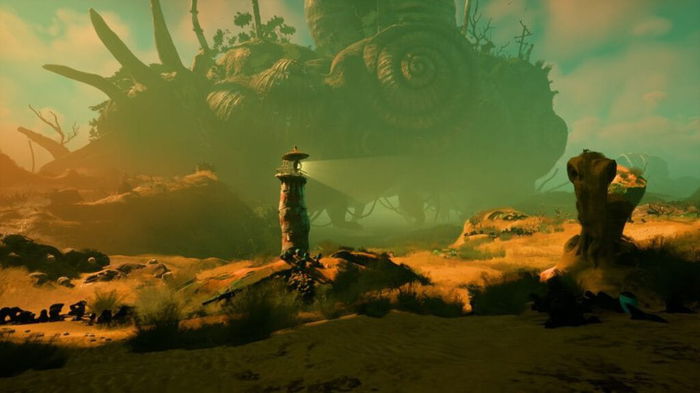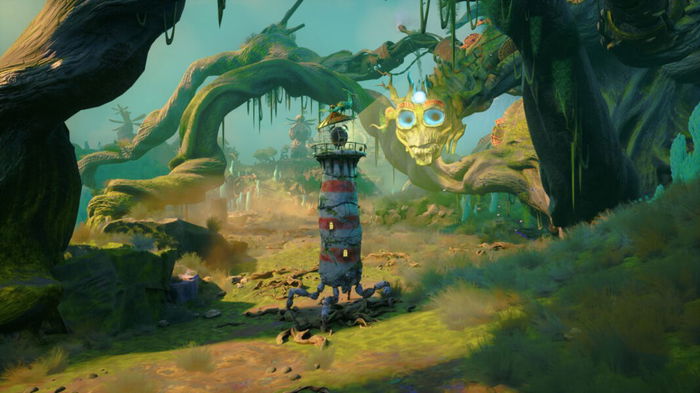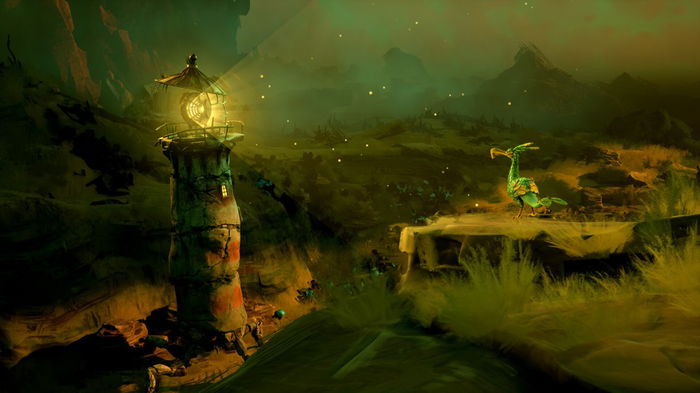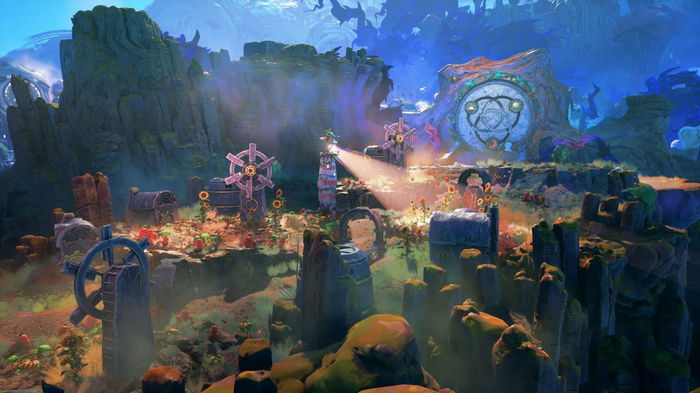Double Fine Productions, the studio known for titles such as Psychonauts 2 and Broken Age, returns in 2025 with a work that departs from conventional standards: Keeper. It's a game that embraces silence, contemplation, and the symbolic power of light, presenting a unique artistic experience far removed from the frenetic action of major blockbusters.
Released for PC and Xbox Series X|S, with a Day One debut on Game Pass, Keeper shows that Double Fine is still capable of surprising by combining visual beauty, an authorial concept, and an almost philosophical reflection on the role of the player as an observer and agent of change. In this review, we'll explore everything the game has to offer, from its atmosphere, gameplay, themes, and emotional impact.

Premise and Setting
In Keeper, the player assumes the role of a wandering lighthouse that awakens on a forgotten island in the middle of a silent ocean. Without words, without long tutorials, only through gestures, light, and movement, the game invites the player to understand the world around them and their purpose within it.
The island is alive and, at the same time, decaying. There’s a mysterious presence called "Withering", a kind of natural deterioration that seems to consume the environment. The lighthouse's mission is to bring its light to every corner of this territory, purifying and restoring balance to the ecosystem.
Accompanied by a seabird, the silent protagonist experiences an almost spiritual journey. This relationship between the lighthouse and the bird becomes a symbol of companionship, interdependence, and hope. The game speaks of rebuilding, of reconnecting with the world, and of the power of presence even in a universe where humans no longer exist.
Keeper is an ecological and emotional fable. A world without words, but full of meanings hidden in the landscape, light, and sound.
Mechanics and Gameplay
Keeper is a lighthearted exploration and puzzle game. The lighthouse moves slowly and imposingly, with a light that serves both to illuminate and interact with the environment. This light can awaken plants, activate ancient mechanisms, and even influence creatures.
Progression is organic: the player learns through experimentation, not through menus or direct instructions. Gradually, new abilities are acquired, such as expanding the light's range, swimming in deep waters, and sliding on dunes, heightening the sense of discovery.
The puzzles are simple yet creative. Many of them revolve around manipulating the light to guide energy flows, open passages, or revive natural elements. It's less a logic challenge and more a choreography between the player and the environment.
There’s no combat, no enemies. Keeper is, essentially, a peaceful experience. This may frustrate those seeking action, but that's precisely what makes it different. The feeling is of cleansing, healing, and observing the world, not destroying it.

Visuals, Atmosphere and Art Direction
If there's one reason to play Keeper, it's its art. Visually, the game is stunning. Each setting feels like a living painting, with colors that shift according to the narrative's mood.
There's a blend of surrealism and nature. Environments recall Salvador Dalí paintings, 1980s fantasy films, and classic Japanese animation. The textures are soft, the lighting is magnificent, and the contrast between light and dark is the visual heart of the experience.
The art direction is accompanied by a soundtrack that breathes with the world. The sounds are divine, the instruments are minimalist, and the moments of silence are as impactful as the music. Each setting has its own identity: forests of blue mist, golden deserts, and ruins covered in bioluminescent vegetation.
The result leaves us hypnotized. It's impossible not to stop and admire the scenery, and the game itself seems to tell the story through these landscapes. In Keeper, the visuals aren't just a backdrop; they're the protagonist.
Narrative and Theme
The narrative is practically non-existent in traditional terms, and this is intentional. There are no lines of dialogue or long text. What drives the story are the subtle transformations of the world, the bird's behavior, and the change in the lighthouse's light.
This lack of explanation leaves room for the player's interpretation. The game is about isolation, new beginnings, and coexistence. It’s an environmental and existential parable, where each player can project their own meanings through the events they experience during the game.
The journey can be seen in many ways: a metaphor for grief, the extinction of humanity, or overcoming life. Double Fine has always been a master at hiding complex emotions in simple premises, and Keeper is perhaps their most mature expression.
The ending - no spoilers - is a moment of pure reflection. There’s no victory, only transformation. And this sense of peace, at the end of the journey, is Keeper's* true reward.

Duration, Pace and Experience
The game lasts between six and eight hours. It's a short adventure, but dense with meaning. The pace is slow, as if the game wants you to take in the details, breathe, and feel the environment.
Each new area brings a slight change in tone and mechanics, avoiding repetition. Still, there are times when the pace can feel dragged, especially for those expecting constant progression.
The design invites the player to explore the environment. It's a game to play slowly, perhaps in two or three sessions, absorbing as many details, subtleties, and visual differences as possible. The ending arrives quickly, leaving a sense of a complete journey, even if it's short.
Pros and Cons
Pros
- Sublime art direction, with masterful use of light and color.
- Atmospheric soundtrack, reinforcing the contemplative tone.
- Symbolic narrative, open to interpretation and full of poetry.
- Accessible, intuitive, and frustration-free gameplay.
- Unique identity, a game that stands out for its originality and artistic courage.
Cons
- Limited challenge: Puzzles are more meditative than demanding.
- Short length, which may leave some players wanting more.
- Slow camera and pacing, which may tire impatient players.
- Lack of clear objectives at times may cause confusion for those who prefer a more straightforward direction.

Target Audience
Keeper is recommended for those seeking artistic, sensory, and introspective experiences. Players who enjoy titles like Journey, Abzû, or The Pathless will find something equally enchanting here.
If you enjoy games with open-ended stories, stunning visuals, and a focus on atmosphere, Keeper is a great fit. On the other hand, those seeking action, traditional narrative, or long-running gameplay may find it too minimalist.
Technical Analysis
On Xbox Series X|S consoles and PC, Keeper delivers excellent performance. The frame rate is stable, load times are minimal, and the graphical quality is impressive, even without requiring high-end hardware.
On Series X, the game runs at 4K at 60fps, with dynamic lighting and smooth reflections. On Series S, it maintains 1440p with exemplary fluidity. On PC, the optimization is solid and scalable, allowing even mid-range machines to achieve satisfactory results.
There are no serious bugs or noticeable drops, which reinforces the studio's technical care. The soundtrack and ambient sound are impeccably mixed, taking advantage of spatial audio.
In short, Keeper is as polished technically as it is artistically. It's a game that respects the player's time and hardware, delivering a fluid, stable, and enchanting experience.
Personal Experience
My experience with Keeper was enchanting. Within the first few hours, I realized it wasn't a game to "beat," but to feel. The way the light spreads, the way the creatures react, the way the silence carries emotion—everything made me slow down.
There were moments when I simply stopped to take in the beauty of the scenery. The distant sound of the waves, the birds flying around me, the breathing of the world. I felt something rare: the sensation of being in a dream, where every step had a meaning, even if hidden.
Even though I wished it could last longer, Keeper left a deep impression on me. It's the kind of game that doesn't scream but remains resonant within you after you turn off the console.
Tips for Beginners
- Play Slowly: Keeper is meant to be felt, not rushed. Explore every corner.
- Observe the Environment: Many secrets lie in the subtle changes of color and sound.
- Use Light Purposefully: Experiment with lighting different areas; the game responds in surprising ways.
- Don't Be Afraid to Get Lost: Part of the journey is finding your way through intuition.
- Play with Headphones: Sound design is essential for immersion.

Conclusion
Keeper is a poetic experience about light, life, and new beginnings. A game that doesn't try to compete with giants but rather to illuminate its own space within the industry.
With beautiful art direction, a quiet narrative, and an almost spiritual atmosphere, Double Fine delivers one of the most unique titles of 2025. It's a powerful reminder that not every game needs to be loud, difficult, or grandiose to be memorable.
If you allow Keeper to envelop you in its calm and symbolic rhythm, you'll find an unforgettable journey, one that doesn't end when the screen fades to black. It's a game about the power of light, but above all, about the power of silence.













— Comentários 0
, Reações 1
Seja o primeiro a comentar